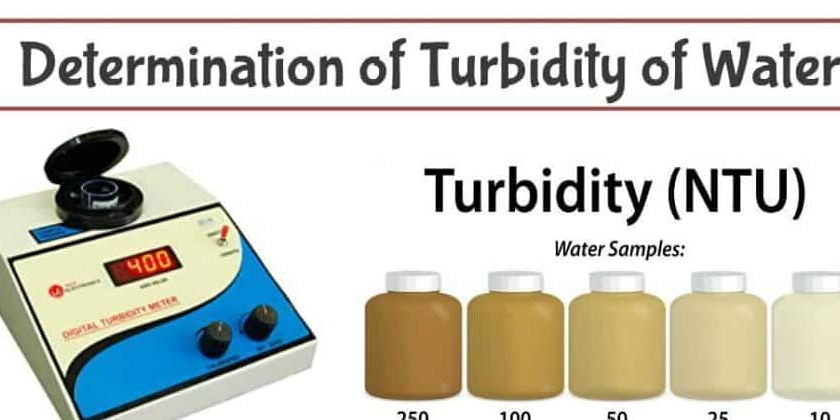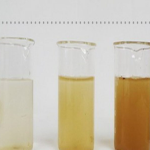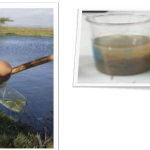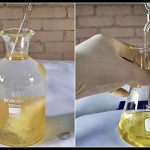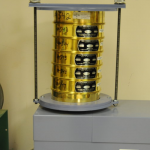Introduction
Water is said to be turbid, in simple terms, if it is “dirty”. In a turbid water, light transmission is inhibited. Thus, turbidity can be defined as the cloudiness or haziness of a fluid. This cloudiness is caused by suspended solids in the water. Suspended solids are almost always present in water and they consist of many different particles of varying sizes. Some of the particles are large enough and heavy enough to eventually settle to the bottom of a container if a sample is left standing (these are called settleable solids). The smaller particles will only settle slowly, if at all (these are the colloidal solids). It’s these particles that cause the water to look turbid. These particles will likely not settle because of their very low mass and density. Thus, to make them settle, one would have to make them combine into larger masses.
However, these particles are negatively charged, and since like charges repel, they tend to move farther apart from the neighboring particles and thus settling never occurs. This is why a water sample which has too much suspended small particles present in it (highly turbid) will most likely remain likely.
Now, to mitigate water turbidity, positive charges need to be induced into the water sample, mostly by adding a coagulant such as alum (which is made up of Al3+) and performing consecutive procedures known as Coagulation and Flocculation on the water.
What Causes Turbidity?
Turbidity can be caused by several materials, including clays and other tiny inorganic particles, algae, and organic matter. In the drinking water treatment process, turbidity is of great importance, partly because turbid water is aesthetically displeasing, and also because the presence of tiny colloidal particles makes it more difficult to remove or inactivate pathogenic organisms.
Natural events like erosions, weatherings, eruptions, storms, winds, and storm water from paved surfaces like roads, bridges and parking lots also contribute to turbidity. Also, human activities like construction, mining and agriculture, disturb the soil and can lead to raised levels of sediment which run off into waterways during storms.
Effects of Turbidity
- In drinking water the higher the level of turbidity, the higher the chance that those using it could develop gastrointestinal diseases. This is because contaminants like viruses and pathogenic bacteria have the ability to attach themselves to the suspended solids in water.
- During the rainy season when mud and silt are washed into rivers and streams, high turbidity can quickly block filters and stop them from working effectively.
- High turbidity levels can reduce the amount of light reaching lower depths in bodies of water like rivers, lakes and reservoirs, which inhibits growth of some forms of aquatic plants and can negatively affect species that are dependent on them, like fish and shellfish.
- High turbidity will also fill tanks and pipes with mud and silt, and can damage valves and taps.
- High turbidity levels will also hinder a fish’s ability to absorb dissolved oxygen.
- When disinfectants such as Chlorine are added to water, even quite low turbidity will prevent them from killing the germs in the water efficiently.
Measurement of Turbidity
Turbidity in water is mostly measured using turbidity meters; however, there are several ways by which it can be measured. Turbidity result is usually presented in Nephelometric Turbidity Units (NTU) or Jackson Turbidity Units (JTU), depending on the method used for measurement. Roughly, the two units of measurement are equal.
In the Jackson Candle method (where results are presented in JTU), It uses a candle flame viewed through a clear column filled with water. The length of water that the candle could be seen through related to the turbidity in the water sample. With the advent of electronic meter technology this method is no longer used. Nephelometric method (where results are presented in NTU), is based on the principle that the particles suspended in the water will scatter a light beam focused on them. The scattered light is then measured at various angles from the incident light path. This is now accepted as a more precise measure of turbidity. To measure turbidity this way, a nephelometer is used. Example of this type of nephelometer is the LaMotte 2020we. The word “Nephelometric” was coined from the Greek words “nephele” and “metric” which mean “cloud” and ”measure” respectively. Thus, Nephelometric literally translate to “measuring cloudiness”.
To measure turbidity in natural water bodies such as the oceans, rivers, and lakes, a Secchi disk can be used. A Secchi disk is a black and white disk that is lowered into the water until it can no longer be seen, and then raised until it can be seen again. The average of these two distances is known as the “Secchi Depth”. The correlating number is recorded as a measure of the clarity in the water.
Using Turbidity Meters for Measurements
Different turbidity measurement devices do not necessarily produce compatible data, even when calibrated to the same standards. The differences in results from different turbidity meters may be due to difference in the following properties:
- Shape
- Source of Light
- Angle of Light
Thus, considering these differences, the use of consistent procedures and instruments within and among projects or programs for which turbidity data will be compared over space and time is crucial for the success of the data-collection program.
As mentioned above, there are several types of turbidity meter and there is specific guidelines and manuals for each type. Thus, you should refer to the manufacturer’s instruction for use and maintenance of the meter which you are interested in. The LaMotte 2020we type is shown below.
Click Here to view and download the instruction manual for this type of turbidity meter and other types.
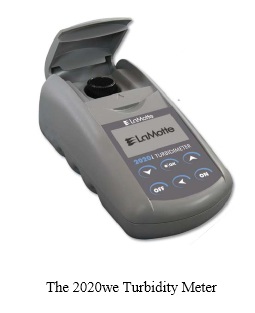
Conclusion and Discussions
- Drinking water should not have a turbidity greater than 5 NTU/JTU. Turbidity of more than 5 NTU/JTU would be noticed by users and may cause rejection of the supply.
- Where water is disinfected, turbidity should be less than 5 NTU/JTU and preferably less than 1 NTU/JTU for chlorination to be effective.
- Clean plastic or glass containers may be used for turbidity samples.
- Ideally, samples should be tested soon after collection and at the same temperature as when collected.
References
- Weiner, R.F. and Matthews, R. (2003). ‘Environmental Engineering – Fourth Edition’. Butterworth-Heinemann Publications, USA.
- Fact Sheet 2.33. “Turbidity measurement”
- LaMotte. “Turbidity”. http://www.lamotte.com/en/blog/test-factors/91-what-is-turbidity/ Assessed on March 18, 2018.
- LaMotte 2020e/i Turbidity Meter Instruction Manual.
- Lewis, J., Eads R. and Klein R. “Comparisons of Turbidity Data Collected with Different Instruments”. Report on a Cooperative Agreement Between the California Department of Forestry and Fire Protection and USDA Forest Service- Pacific Southwest Research Station (PSW Agreement # 06-CO-11272133-041).
Download “Turbidity of Water Sample”
Turbidity-of-Water-Sample-1.docx – Downloaded 0 times – 419.76 KB
